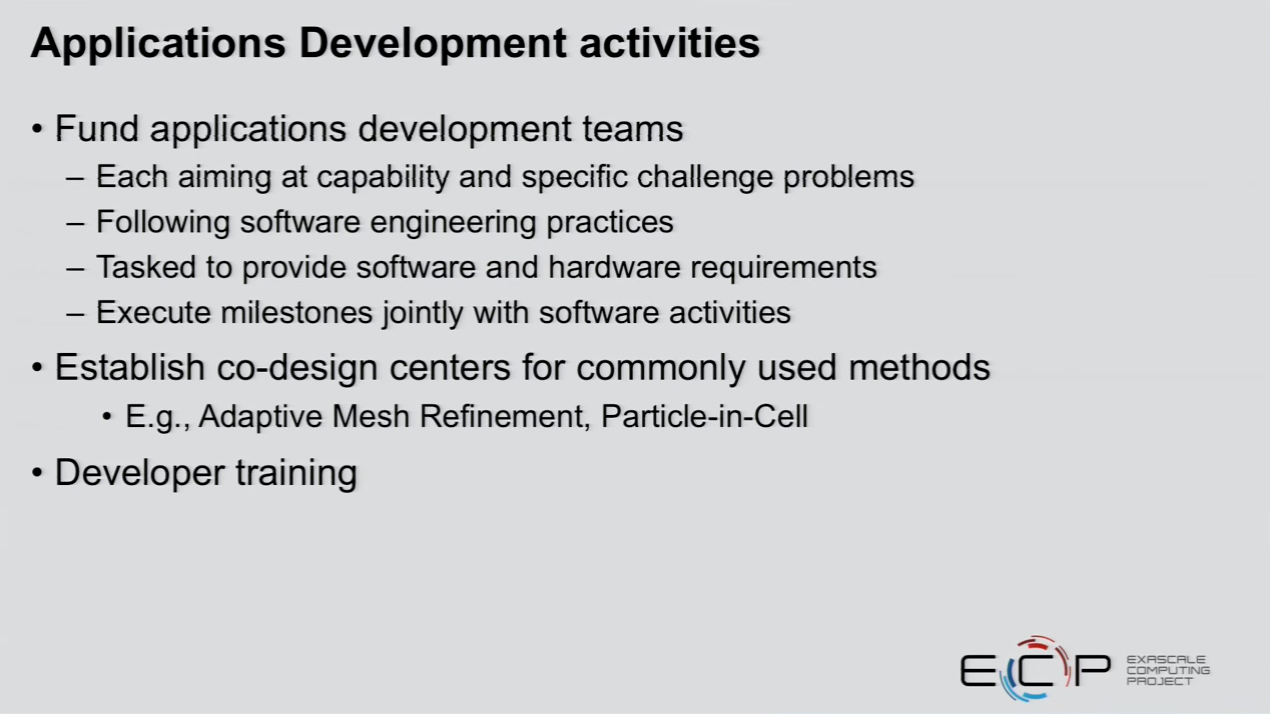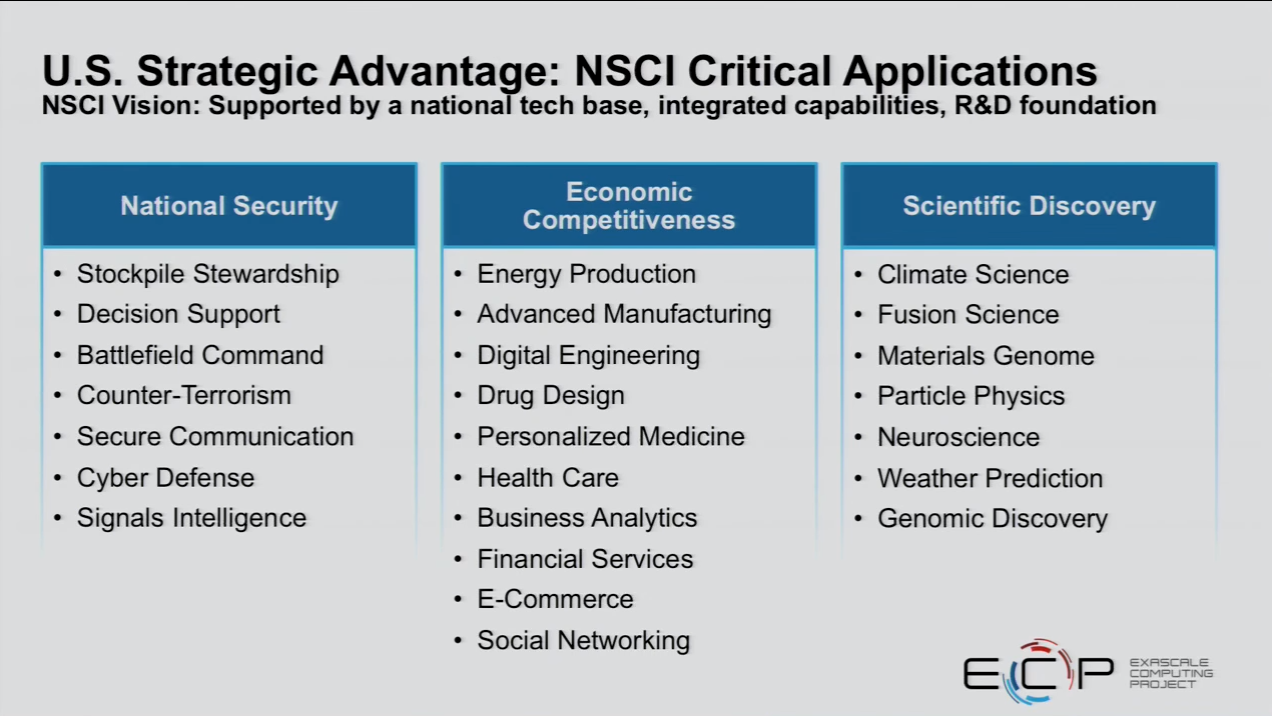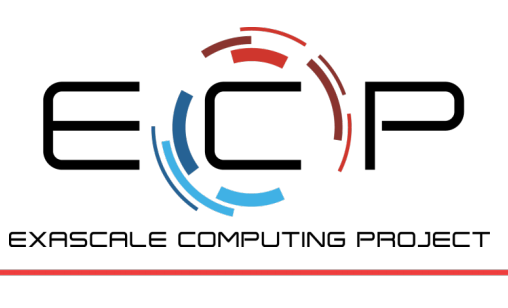The Department of Energy’s Exascale Computing Project (ECP) hit an important milestone today with the announcement of its first round of funding, moving the nation closer to its goal of reaching capable exascale computing by 2023. As part of a $39.8 million award round, the ECP will provide full funding to 15 application development proposals and seed funding for seven more proposals, impacting 22 total projects and 45 research and academic organizations.
The winning projects were selected both for their significance to society and their ability to be advanced by exascale computing. Domain areas encompass clean energy, national and economic security, scientific discovery, climate and environmental science, and precision medicine.

Co-design capabilities also factored heavily in the selection process since integration and co-design are essential to ensuring the ECP can meet its goal of a production exascale systems, defined by the ECP as being 50-100 times faster than today’s speediest number crunchers.
“These application development awards are a major first step toward achieving mission critical application readiness on the path to exascale,” said ECP director Paul Messina in an official statement. “A key element of the ECP’s mission is to deliver breakthrough HPC modeling and simulation solutions that confidently deliver insight and predict answers to the most critical U.S. problems and challenges in scientific discovery, energy assurance, economic competitiveness, and national security. Application readiness is a strategic aspect of our project and foundational to the development of holistic, capable exascale computing environments.”
Developing a broad set of modeling and simulation applications that support the scientific, engineering, and nuclear security programs of the DOE is one of four primary ECP goals. Its other major goals are to develop productive exascale computing (hardware and software) by 2023; prepare two or more DOE facilities to house exascale machines in that same timeframe; and to maximize the benefits of HPC to empower US science and commerce.
The full list of application development awards with PIs is reproduced below. Fully-funded projects will receive funding over four years. “Seed” projects are slated to receive start-up funding over three years.
Full Funding:
1. Computing the Sky at Extreme Scales, Salman Habib (ANL) with LANL, LBNL
2. Exascale Deep Learning and Simulation Enabled Precision Medicine for Cancer, Rick Stevens (ANL) with LANL, LLNL, ORNL, NIH/NCI
3. Exascale Lattice Gauge Theory Opportunities and Requirements for Nuclear and High Energy Physics, Paul Mackenzie (FNAL) with BNL, TJNAF, Boston University, Columbia University, University of Utah, Indiana University, UIUC, Stony Brook, College of William & Mary
4. Molecular Dynamics at the Exascale: Spanning the Accuracy, Length and Time Scales for Critical Problems in Materials Science, Arthur Voter (LANL) with SNL, University of Tennessee
5. Exascale Modeling of Advanced Particle Accelerators, Jean-Luc Vay (LBNL) with LLNL, SLAC
6. An Exascale Subsurface Simulator of Coupled Flow, Transport, Reactions and Mechanics, Carl Steefel (LBNL) with LLNL, NETL
7. Exascale Predictive Wind Plant Flow Physics Modeling, Steve Hammond (NREL) with SNL, ORNL, University of Texas Austin
8. QMCPACK: A Framework for Predictive and Systematically Improvable Quantum‐Mechanics Based Simulations of Materials, Paul Kent (ORNL) with ANL, LLNL, SNL, Stone Ridge Technology, Intel, Nvidia
9. Coupled Monte Carlo Neutronics and Fluid Flow Simulation of Small Modular Reactors, Thomas Evans (ORNL, PI) with ANL, INL, MIT
10. Transforming Additive Manufacturing through Exascale Simulation (TrAMEx), John Turner (ORNL) with LLNL, LANL, NIST
11. NWChemEx: Tackling Chemical, Materials and Biomolecular Challenges in the Exascale Era, T. H. Dunning, Jr. (PNNL), with Ames, ANL, BNL, LBNL, ORNL, PNNL, Virginia Tech
12. High-Fidelity Whole Device Modeling of Magnetically Confined Fusion Plasma, Amitava Bhattacharjee (PPPL) with ANL, ORNL, LLNL, Rutgers, UCLA, University of Colorado
13. Data Analytics at the Exascale for Free Electron Lasers, Amedeo Perazzo (SLAC) with LANL, LBNL, Stanford
14. Transforming Combustion Science and Technology with Exascale Simulations, Jackie Chen (SNL) with LBNL, NREL, ORNL, University of Connecticut
15. Cloud-Resolving Climate Modeling of the Earth’s Water Cycle, Mark Taylor (SNL) with ANL, LANL, LLNL, ORNL, PNNL, UCI, CSU
Seed Funding
1. Enabling GAMESS for Exascale Computing in Chemistry & Materials, Mark Gordon (Ames) with ANL, ORNL, Iowa State University, Georgia Tech, Old Dominion University, Australian National University, EP Analytics, NVIDIA
2. Multiscale Coupled Urban Systems, Charlie Catlett (ANL) with LBNL, NREL, ORNL, PNNL
3. Exascale Models of Stellar Explosions: Quintessential Multi-Physics Simulation, Daniel Kasen (LBNL), with ANL, ORNL, Stony Brook, University of Chicago
4. Exascale Solutions for Microbiome Analysis, Kathy Yelick (LBNL) with LANL, Joint Genome Institute
5. High Performance, Multidisciplinary Simulations for Regional Scale Seismic Hazard and Risk Assessments, David McCallen (LBNL) with LLNL, UC Davis, UC Berkeley
6. Performance Prediction of Multiphase Energy Conversion Devices with Discrete Element, Particle-in-Cell, and Two-Fluid Models (MFIX-Exa), Madhava Syamlal (NETL) with LBNL, University of Colorado
7. Optimizing Stochastic Grid Dynamics at Exascale, Henry Huang (PNNL) with ANL, NREL
The ECP is executed by the DOE’s Office of Science and the National Nuclear Security Administration; it is the DOE’s contribution to President Obama’s National Strategic Computing Initiative (NSCI).

Dr. Messina will be speaking about ECP developments this morning at the HPC User Forum in Austin, Texas. As part of the program devoted to exascale initiatives around the world, Leonardo Flores of the European Commission and Yutaka Ishikawa of RIKEN will also be presenting.




























































